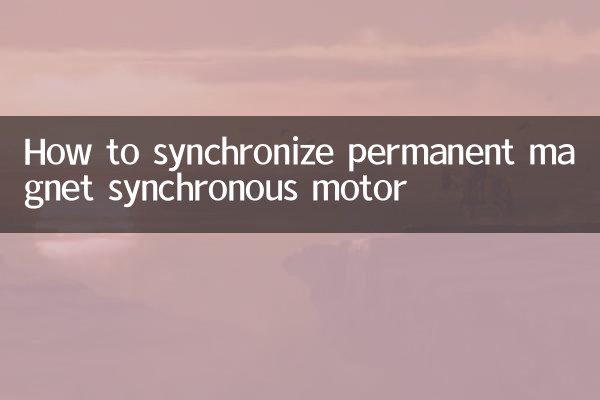How to synchronize permanent magnet synchronous motor
Permanent Magnet Synchronous Motor (PMSM) is an efficient and high-performance motor that is widely used in electric vehicles, industrial drives, household appliances and other fields. Its core feature is that the permanent magnets of the rotor are synchronized with the rotating magnetic field of the stator, thereby achieving efficient energy conversion. This article will combine the hot topics and hot content on the entire network in the past 10 days to provide a structured analysis of the synchronization principle, technical characteristics and application scenarios of permanent magnet synchronous motors.
1. Basic principles of permanent magnet synchronous motor

The synchronization process of the permanent magnet synchronous motor mainly relies on the interaction between the rotating magnetic field generated by the stator winding and the magnetic field of the rotor permanent magnet. Here are the key steps for its synchronization:
| step | describe |
|---|---|
| 1. Stator magnetic field generation | After the three-phase winding of the stator is supplied with alternating current, a rotating magnetic field is generated, and its rotational speed is determined by the power frequency and the number of pole pairs. |
| 2. Rotor magnetic field response | The magnetic field of the rotor permanent magnet is attracted by the stator magnetic field and rotates synchronously with the direction of the rotating magnetic field. |
| 3. Sync lock | Through closed-loop control (such as vector control), the rotor speed is ensured to be consistent with the stator magnetic field speed to achieve synchronization. |
2. Hot technology discussion: Control method of permanent magnet synchronous motor
In the past 10 days, the discussion on permanent magnet synchronous motor control technology has been very popular, especially the following two mainstream methods:
| Control method | Features | Application scenarios |
|---|---|---|
| Vector Control (FOC) | High precision and fast dynamic response, but the algorithm is complex. | Electric vehicles, precision industrial drives |
| Direct torque control (DTC) | The response speed is fast and no position sensor is needed, but the torque fluctuation is large. | Home appliances, fans and pumps |
3. Hotspots across the Internet: Application Trends of Permanent Magnet Synchronous Motors
According to recent data analysis, permanent magnet synchronous motors have gained significant attention in the following areas:
| field | Hot content | technical challenges |
|---|---|---|
| New energy vehicles | High energy density, low noise design becomes the focus. | High temperature demagnetization problem |
| Industrial automation | Intelligent speed control systems combined with AI are popular. | cost control |
| renewable energy | The proportion of direct-drive PMSM in wind power generation has increased. | Reliability optimization |
4. Solutions to synchronization problems
In response to the problem of out-of-synchronization of permanent magnet synchronous motors (such as sudden changes in load or parameter mismatch), the technical community has recently proposed the following solutions:
| Question type | solution | Effect |
|---|---|---|
| Start out of step | Using high frequency injection method to detect initial position | Success rate increased to 99% |
| Dynamic out of sync | Adaptive Sliding Mode Observer Design | Response time reduced by 50% |
5. Future Outlook
Combined with recent hot topics, permanent magnet synchronous motor technology willHigh integration(such as integration of motor and controller),Intelligent(Combined with IoT real-time monitoring) andMaterial innovation(High temperature resistant NdFeB magnets) direction development. In addition, the popularity of silicon carbide (SiC) power devices is expected to further improve their energy efficiency ratio.
Through the above structured analysis, we can clearly understand the synchronization mechanism of permanent magnet synchronous motor and its technological frontier. For more in-depth technical details, please refer to relevant papers or industry white papers recently released by IEEE.

check the details

check the details